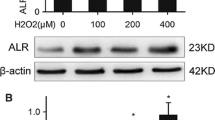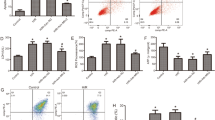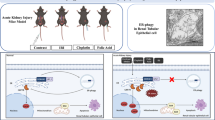Abstract
Ischemia/reperfusion is a major cause of acute kidney injury and can induce apoptosis in renal epithelial tubule (HK-2) cells. Accumulating evidence indicates that endoplasmic reticulum (ER) stress is a major contributor to apoptosis in acute kidney injury. We previously reported that augmenter of liver regeneration (ALR) functions as an anti-apoptotic factor in H2O2-treated HK-2 cells although the precise mechanism underlying this action remains unclear. In the present study, we investigate the role of ALR in H2O2-induced ER stress-mediated apoptosis. We overexpressed ALR and established a H2O2-induced ER stress model in HK-2 cells. Overexpression of ALR reduced the level of reactive oxygen species and the rate of apoptosis in H2O2-treated HK-2 cells. Using confocal microscopy and western blot, we observed that ALR colocalized with the ER and mitochondria compartment. Moreover, ALR suppressed ER stress by maintaining the morphology of the ER and reducing the levels of the ER-related proteins, glucose-regulated protein 78 (GRP78), phospho-protein kinase-like ER kinase (p-PERK), phospho-eukaryotic initiation factor 2α (p-eIF2α) and C/EBP-homologous protein (CHOP) significantly (p < 0.05). Mechanistically, ALR promoted Bcl-2 expression and suppressed Bax and cleaved-caspase-3 expression significantly during ER-stress induced apoptosis (p < 0.05). Furthermore, ALR attenuated calcium release from the ER, and transfer to mitochondria, under ER stress. To conclude, ALR alleviates H2O2-induced ER stress-mediated apoptosis in HK-2 cells by suppressing ER stress response and by maintaining calcium homeostasis. Consequently, ALR may protect renal tubule epithelial cells from ischemia/reperfusion induced acute kidney injury.







Similar content being viewed by others
References
Zuk A, Bonventre JV (2016) Acute kidney injury. Annu Rev Med 67(1):293–307. https://doi.org/10.1146/annurev-med-050214-013407
Bellomo R, Kellum JA, Ronco C (2012) Acute kidney injury. Lancet 380(9843):756–766. https://doi.org/10.1016/s0140-6736(11)61454-2
Arai S, Kitada K, Yamazaki T, Takai R, Zhang X, Tsugawa Y, Sugisawa R, Matsumoto A, Mori M, Yoshihara Y, Doi K, Maehara N, Kusunoki S, Takahata A, Noiri E, Suzuki Y, Yahagi N, Nishiyama A, Gunaratnam L, Takano T, Miyazaki T (2016) Apoptosis inhibitor of macrophage protein enhances intraluminal debris clearance and ameliorates acute kidney injury in mice. Nat Med 22:183. https://doi.org/10.1038/nm.4012
Basile DP, Anderson MD, Sutton TA (2012) Pathophysiology of acute kidney injury. Compr Physiol 2(2):1303–1353. https://doi.org/10.1002/cphy.c110041
Dennis MJ, Witting KP (2017) Protective role for antioxidants in acute kidney disease. Nutrients. https://doi.org/10.3390/nu9070718
Ali I, Shah SZ, Jin Y, Li ZS, Ullah O, Fang NZ (2017) Reactive oxygen species-mediated unfolded protein response pathways in preimplantation embryos. J Vet Sci 18(1):1–9. https://doi.org/10.4142/jvs.2017.18.1.1
Qin C, Xiao C, Su Y, Zheng H, Xu T, Lu J, Luo P, Zhang J (2017) Tisp40 deficiency attenuates renal ischemia reperfusion injury induced apoptosis of tubular epithelial cells. Exp Cell Res 359(1):138–144. https://doi.org/10.1016/j.yexcr.2017.07.038
Noh MR, Kim JI, Han SJ, Lee TJ, Park KM (2015) C/EBP homologous protein (CHOP) gene deficiency attenuates renal ischemia/reperfusion injury in mice. Biochim Biophys Acta 1852(9):1895–1901. https://doi.org/10.1016/j.bbadis.2015.06.004
Chen BL, Sheu ML, Tsai KS, Lan KC, Guan SS, Wu CT, Chen LP, Hung KY, Huang JW, Chiang CK, Liu SH (2015) CCAAT-enhancer-binding protein homologous protein deficiency attenuates oxidative stress and renal ischemia-reperfusion injury. Antioxid Redox Signal 23(15):1233–1245. https://doi.org/10.1089/ars.2013.5768
Bravo-Sagua R, Rodriguez AE, Kuzmicic J, Gutierrez T, Lopez-Crisosto C, Quiroga C, Diaz-Elizondo J, Chiong M, Gillette TG, Rothermel BA, Lavandero S (2013) Cell death and survival through the endoplasmic reticulum-mitochondrial axis. Curr Mol Med 13(2):317–329. https://doi.org/10.2174/1566524011313020008
Oyadomari S, Mori M (2003) Roles of CHOP/GADD153 in endoplasmic reticulum stress. Cell Death Differ 11:381. https://doi.org/10.1038/sj.cdd.4401373
Zhou X, Hao W, Shi H, Hou Y, Xu Q (2015) Calcium homeostasis disruption—a bridge connecting cadmium-induced apoptosis, autophagy and tumorigenesis. Oncol Res Treat 38(6):311–315
Pinton P, Giorgi C, Siviero R, Zecchini E, Rizzuto R (2008) Calcium and apoptosis: ER-mitochondria Ca2+ transfer in the control of apoptosis. Oncogene 27:6407. https://doi.org/10.1038/onc.2008.308
Rizzuto R, Marchi S, Bonora M, Aguiari P, Bononi A, De Stefani D, Giorgi C, Leo S, Rimessi A, Siviero R, Zecchini E, Pinton P (2009) Ca2+ transfer from the ER to mitochondria: when, how and why. Biochim Biophys Acta (BBA) Bioenergetics 1787(11):1342–1351. https://doi.org/10.1016/j.bbabio.2009.03.015
Nalesnik MA, Gandhi CR, Starzl TE (2017) Augmenter of liver regeneration: a fundamental life protein. Hepatology 66(1):266–270. https://doi.org/10.1002/hep.29047
Hagiya M, Fracavailla A, Polimeno L, Ihara I, Sakai H, Seki T, Shimonishi M, Porter KA, Starzl TE (1994) Cloning and sequence analysis of the rat augmenter of liver regeneration (ALR) gene: expression of biologically active recombinant ALR and demonstration of tissue distribution. Proc Natl Acad Sci USA 91(17):8142–8146
Liao X-h, Zhang L, Liu Q, Sun H, Peng C-m, Guo H et al (2010) Augmenter of liver regeneration protects kidneys from ischaemia/reperfusion injury in ratsX. Nephrol Dial Transplant 25(9):2921–2929. https://doi.org/10.1093/ndt/gfq151
Tury A, Mairet-Coello G, Lisowsky T, Griffond B, Fellmann D (2005) Expression of the sulfhydryl oxidase ALR (augmenter of liver regeneration) in adult rat brain. Brain Res. https://doi.org/10.1016/j.brainres.2005.04.050
Gandhi CR (2012) Augmenter of liver regeneration. Fibrogenes Tissue Repair 5(1):10. https://doi.org/10.1186/1755-1536-5-10
Lange H, Lisowsky T, Gerber J, Mühlenhoff U, Kispal G, Lill R (2001) An essential function of the mitochondrial sulfhydryl oxidase Erv1p/ALR in the maturation of cytosolic Fe/S proteins. EMBO Rep. https://doi.org/10.1093/embo-reports/kve161
Sevier CS, Cuozzo JW, Vala A, Åslund F, Kaiser CA (2001) A flavoprotein oxidase defines a new endoplasmic reticulum pathway for biosynthetic disulphide bond formation. Nat Cell Biol 3:874. https://doi.org/10.1038/ncb1001-874
Polimeno L, Pesetti B, De Santis F, Resta L, Rossi R, De Palma A, Girardi B, Amoruso A, Francavilla A (2012) Decreased expression of the augmenter of liver regeneration results in increased apoptosis and oxidative damage in human-derived glioma cells. Cell Death Dis 3:e289. https://doi.org/10.1038/cddis.2012.25
Xia N, Yan RY, Liu Q, Liao XH, Sun H, Guo H, Zhang L (2015) Augmenter of liver regeneration plays a protective role against hydrogen peroxide-induced oxidative stress in renal proximal tubule cells. Apoptosis Int J Progr Cell Death 20(4):423–432. https://doi.org/10.1007/s10495-015-1096-2
Liu XR, Cao L, Li T, Chen LL, Yu YY, Huang WJ, Liu L, Tan XQ (2017) Propofol attenuates H2O2-induced oxidative stress and apoptosis via the mitochondria- and ER-medicated pathways in neonatal rat cardiomyocytes. Apoptosis Int J Progr Cell Death 22(5):639–646. https://doi.org/10.1007/s10495-017-1349-3
Hajnóczky G, Robb-Gaspers LD, Seitz MB, Thomas AP (1995) Decoding of cytosolic calcium oscillations in the mitochondria. Cell 82(3):415–424. https://doi.org/10.1016/0092-8674(95)90430-1
Babcock DF, Herrington J, Goodwin PC, Park YB, Hille B (1997) Mitochondrial participation in the intracellular Ca2+ network. J Cell Biol 136(4):833
Bonventre JV, Yang L (2011) Cellular pathophysiology of ischemic acute kidney injury. J Clin Investig 121(11):4210–4221. https://doi.org/10.1172/JCI45161
Boussabbeh M, Ben Salem I, Prola A, Guilbert A, Bacha H, Abid-Essefi S, Lemaire C (2015) Patulin induces apoptosis through ROS-mediated endoplasmic reticulum stress pathway. Toxicol Sci 144(2):328–337. https://doi.org/10.1093/toxsci/kfu319
Pluquet O, Pourtier A, Abbadie C (2015) The unfolded protein response and cellular senescence. A review in the theme: cellular mechanisms of endoplasmic reticulum stress signaling in health and disease. Am J Physiol Cell Physiol 308(6):C415–C425. https://doi.org/10.1152/ajpcell.00334.2014
Zhu G, Lee AS (2015) Role of the unfolded protein response, GRP78 and GRP94 in organ homeostasis. J Cell Physiol 230(7):1413–1420. https://doi.org/10.1002/jcp.24923
Fu XL, Gao DS (2014) Endoplasmic reticulum proteins quality control and the unfolded protein response: the regulative mechanism of organisms against stress injuries. BioFactors 40(6):569–585. https://doi.org/10.1002/biof.1194
Taniguchi M, Yoshida H (2015) Endoplasmic reticulum stress in kidney function and disease. Curr Opin Nephrol Hypertens 24(4):345–350. https://doi.org/10.1097/MNH.0000000000000141
Verfaillie T, Rubio N, Garg AD, Bultynck G, Rizzuto R, Decuypere JP, Piette J, Linehan C, Gupta S, Samali A, Agostinis P (2012) PERK is required at the ER-mitochondrial contact sites to convey apoptosis after ROS-based ER stress. Cell Death Differ 19(11):1880–1891. https://doi.org/10.1038/cdd.2012.74
Wu C-C, Bratton SB (2012) Regulation of the intrinsic apoptosis pathway by reactive oxygen species. Antioxid Redox Signal 19(6):546–558. https://doi.org/10.1089/ars.2012.4905
Iurlaro R, Muñoz-Pinedo C (2015) Cell death induced by endoplasmic reticulum stress. FEBS J 283(14):2640–2652. https://doi.org/10.1111/febs.13598
Sano R, Reed JC (2013) ER stress-induced cell death mechanisms. Biochim Biophys Acta 1833(12):3460–3470. https://doi.org/10.1016/j.bbamcr.2013.06.028
Qiao Y, Wang C, Xu K, Meng L, Li X, Pei X, Wang J, Meng H, Zeng L (2014) Changes in calcium/calmodulin level and mitochondrial membrane potential in cochlear neurons of newborn mice infected with murine cytomegalovirus. Cell Biochem Biophys 69(3):593–598. https://doi.org/10.1007/s12013-014-9838-2
Deniaud A, Sharaf el dein O, Maillier E, Poncet D, Kroemer G, Lemaire C, Brenner C (2008) Endoplasmic reticulum stress induces calcium-dependent permeability transition, mitochondrial outer membrane permeabilization and apoptosis. Oncogene 27(3):285–299. https://doi.org/10.1038/sj.onc.1210638
Acknowledgements
This study was supported by grants from the National Natural Science Foundation of China (Grant Nos. 81873604 and 30971334), Natural Science Foundation Project of CQ CSTC (Grant No. cstc2015jcyjA10069), Medical Scientific Research Projects of Chongqing Health and Family Planning Commission (Grant No. 20142031) and The Found for Fostering Talents in Scientific Research of Chongqing Medical University (Grant No. 201404).
Author information
Authors and Affiliations
Corresponding author
Ethics declarations
Conflict of interest
The authors declare no conflict of interest.
Additional information
Publisher’s Note
Springer Nature remains neutral with regard to jurisdictional claims in published maps and institutional affiliations.
Rights and permissions
About this article
Cite this article
Jiang, X., Liao, Xh., Huang, Ll. et al. Overexpression of augmenter of liver regeneration (ALR) mitigates the effect of H2O2-induced endoplasmic reticulum stress in renal tubule epithelial cells. Apoptosis 24, 278–289 (2019). https://doi.org/10.1007/s10495-019-01517-z
Published:
Issue Date:
DOI: https://doi.org/10.1007/s10495-019-01517-z




